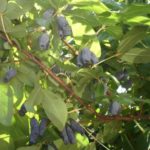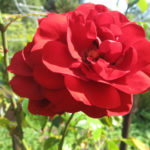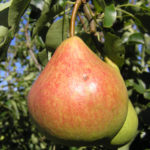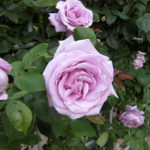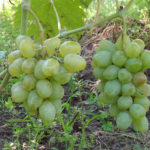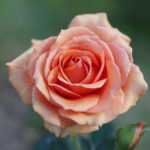Rose Lady of Shalott
David Austin's English roses are recognizable at first sight. The charming old flower shape and strong aroma, combined with robust health, have become the hallmark of these beautiful varieties. Having endowed his creations with the ability to bloom again, the great rose grower began to experiment with color, trying to achieve in the colors of old roses unusual orange shades. The first was a charming Pat Austin, its color combined noble copper shades with coral and amber tints. And then the world was conquered by another English lady - Lady of Shallot, whom Austin called one of the most frost-resistant and hardy in his collection. In a short time, the variety managed to fall in love with many flower growers and achieve prestigious awards.
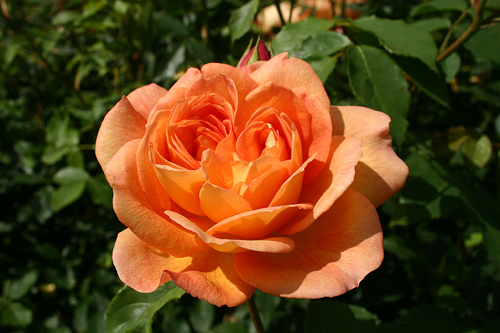
History of creation
Our heroine appeared relatively recently and belongs to the English selection. Place of birth - David Austin Roses Limited family grower nursery. Its pedigree does not contain well-known names, on the contrary, unnamed seedlings took part in the crossing process. But the result turned out to be amazing and successful, and our heroine is ranked among the most elegant and noble varieties. In 2009, David Austin introduced a new variety to the rose-growing world - Lady of Shalott, under this name the variety will now participate in various exhibitions. The registration name includes a unique alphabetic code and sounds like AUSnyson. 2009 marked the 200th anniversary of the birth of the famous English poet, Baron Alfred Tennyson. Therefore, it is no coincidence that the name of the rose was given in honor of the red-haired (as she was often portrayed) heroine of his famous ballad The Sorceress Shallot (in another translation of Lady Shalotte).
Awards
Despite the fact that the biography of our heroine is short, she already has recognition and prestigious awards. In Glasgow, Scotland, a young lady won a silver medal in a rose competition. In 2011, its outstanding performance was recognized by the RNRS Test Certificate of the Rose Competition of the Royal National Rose Society of Great Britain.
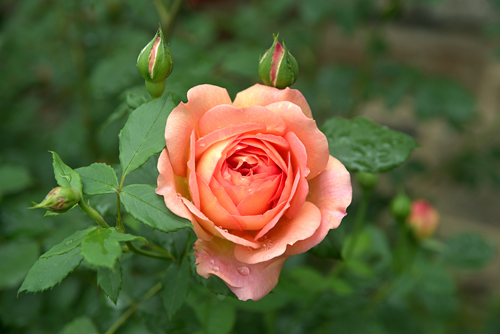
Description
Our heroine belongs to a fairly common shrub species, or scrubs. Many growers note the very good growth of the seedling at a young age. The bush is erect, rather powerful and branched, lush, well leafy. An adult plant, as a rule, does not need support. Shoots of medium thickness, slightly arched, look very graceful, as David Austin intended. There are thorns, but they are small and in small numbers. The declared height is 100 - 120 cm. In places with a warm, favorable climate, a rose can grow up to 250 cm. The usual width of a shrub is about 100 cm, but a tall plant can grow a crown and a larger volume. Leaves are healthy, alternate, pinnate, deep green, medium size. The leaf blade is rounded-elongated, leathery, semi-glossy with serrated edges. Young foliage has a bronze tint. As a rule, the shoots are crowned with inflorescences consisting of 1 to 3 flowers, but the flower cluster often consists of more buds. Under their weight, the shoots seem to bend, allowing you to admire the beautiful flowers up close.
Pointed oval buds, bright orange-red color. The flowers are dense and lush, densely doubled, consist of 40 or more petals with a broad-wavy top. The rosette has a beautiful rounded bowl-like shape reminiscent of old roses. The outer petals are arranged in a spiral, the inner ones are more chaotic and free, due to which the middle of the flower, even in complete dissolution, often remains closed. The rich color range allows you to enjoy the overflow of salmon orange. The inner color of the petals is very delicate, salmon-colored, with a pink tint.The cup-shaped shape and tightly packed petals at the moment of incomplete dissolution make it more saturated, allowing you to see copper shades in depth. A nice intriguing contrast and complement to the inner coloration is the golden yellow underside of the petal. The size of the flower rosette is rather big - 8 - 10 cm, so the flower brush looks full even though the buds do not open at the same time.
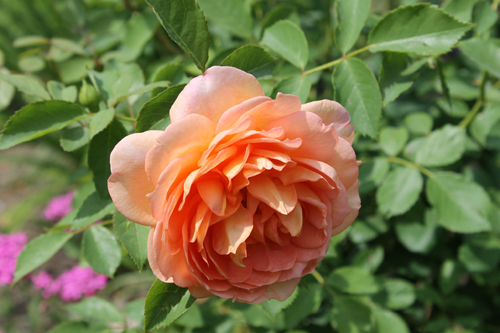
Flowering period
A re-flowering species, the sorceress Lady of Shallot has unusually long flowering periods throughout the season. According to reviews, the last wave of flowering is in no way inferior to the first in abundance and large flowers. A fabulously beautiful rose blooms almost without interruption, starting from late May - early June until the onset of cold weather. The flowers last for about a week, although intense heat or prolonged rains significantly reduce the decorative period of the rosette. In cool weather, the flower opens slowly, but it lasts longer. To maintain the spectacular appearance of the shrub throughout the growing season and stimulate bud formation, the fading rosettes must be removed in time. Ostinka has a medium aroma. It captures notes of apple, spices and cloves, combined with the scent of a tea rose. Many growers still call the smell quite rich, even heavy.
Characteristics
- If the seedling is healthy and strong, the Lady of Shallot rose can bloom already in the year of planting. But the fast-growing Ostinka can truly amaze with its beauty in the second or third year;
- under the influence of sunlight, the bright color of the variety may fade somewhat, acquire pastel shades. But, according to flower growers, the petals do not melt, do not lose turgor and, in general, the flower rosette looks attractive. The southern regions are a different matter. There, too hot rays lead to rapid fading;
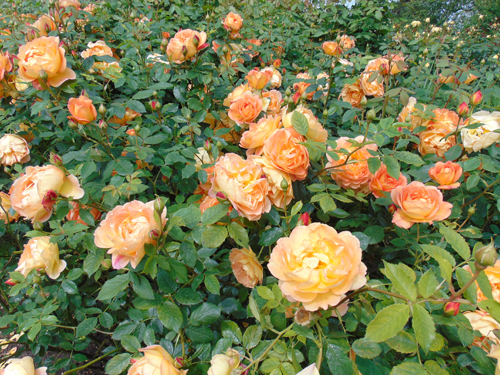
- the declared frost resistance is slightly higher than that of many other representatives of the culture. Our heroine is able to withstand frosts from minus 26.1 ° C to minus 28.9 ° C, which correspond to zone 5 of the USDA (a system adopted by the US Department of Agriculture). Rave reviews of the hardy rose come from many places on our planet, for example, from the south of Alaska, from the Baltic States and Primorsky Krai, thereby confirming its ability to withstand adverse conditions. If the winter temperature indicators in St. Petersburg or the Moscow region do not go beyond the average, then the perennial can do practically without shelter;
- the excellent immunity of the Englishwoman is also of great value. The plant has a high resistance to such insidious crop diseases as powdery mildew and black spot. If prevention is carried out in time, then even in unfavorable epiphytic years, our heroine will not suffer from fungal diseases;
- according to reviews, the culture tolerates the rainy period very well. The rosette can become heavier from moisture and droop, but at the same time it retains its shape, the petals do not deteriorate. True, specks may appear on the outer petals, but they will not spoil the overall impression of the appearance of the bright Englishwoman. Buds can suffer from prolonged rains.
Agrotechnics
The best period for planting Lady of Shallot is considered by many rose growers to be autumn. But you can plant a culture in the spring, however, during this period it should be given more attention. A rose illuminated by the rays of the sun can surprise with a magical and mesmerizing play of color, so choose well-lit places for it, where, moreover, growth abilities will show themselves much better than in the shade. True, in the southern regions, burning rays shorten the life of a flower, so in the midday period the queen of flowers will feel more comfortable in diffused partial shade.
A fast-growing powerful bush withstands wind gusts well, but still the culture must be protected from the wind prevailing in the winter period. The soils are preferable loose, easily permeable to moisture and air, highly nutritious, with neutral acidity. Watering is moderate, but sufficient. To prevent the soil from drying out very quickly, you can use mulch. By the way, bark or crushed wood chips are good in this capacity, not only helping to retain moisture in the root zone, but also suppressing the growth of weeds. During the growing season, feeding is carried out at least 2 times. In autumn, nitrogen is excluded, giving preference to phosphorus and potassium.
Landscape design
The exquisite and unique Lady of Shallot will perfectly decorate any corner of the garden. The soft and warm copper shades of our heroine go well with yellow, pale pink, creamy and white. But no one forbids experimenting with colors and combining the incongruous. Our heroine differs in that the lower part of the bush is not exposed, and this allows you to use it in a single planting or as a decorative hedge. It will harmoniously fit into a complex flower bed known as a mixborder. Traditionally, the rose is wonderfully combined with conifers, which will create a decorative background for the bright and elegant flowers of a beautiful lady. Low hosts will be appropriate at the foot of the flower.
Like a real queen, a beautiful Austin will look majestic even in a flower pot. True, such a planting will require a rather large container, with a volume of at least 60 liters. Growing Lady of Shalott as a pot plant will make it a little more difficult to care for, but it won't make it very difficult. The nuances will mainly relate to watering. In a small volume, the soil dries out much faster, which means that the plant will need to be watered more often.
The English rose Lady of Shallot is not at all a capricious lady. It is perfect even for a novice gardener. True, success will largely depend on the landing site, therefore, it is worth approaching the choice of a site responsibly and making a decision before planting. High immunity greatly facilitates care, but you do not need to completely abandon preventive spraying. Despite the frost resistance, in cool regions it is still worth insulating the shrub, especially the young one. But in the south, excessive care in terms of insulation can lead to damping. Most rose growers speak positively about our heroine. But there is also evidence that the culture does not grow fast enough, does not bloom well and is often sick. But most likely, this is due to mistakes in care or an incorrectly selected area.
